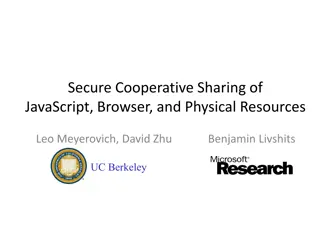Determinants of Unlawful File Sharing: Insights and Implications
This comprehensive review delves into the determinants of unlawful file sharing behavior, exploring factors such as proximity to actual behavior, financial and legal considerations, and the impact on sales. It discusses the reasons behind illegal file sharing, including the influence of laws, pricing, and perceived deterrents. The study also examines the relationship between unlawful file sharing and its effect on sales of digital media, shedding light on both the negative and positive associations.
Download Presentation

Please find below an Image/Link to download the presentation.
The content on the website is provided AS IS for your information and personal use only. It may not be sold, licensed, or shared on other websites without obtaining consent from the author.If you encounter any issues during the download, it is possible that the publisher has removed the file from their server.
You are allowed to download the files provided on this website for personal or commercial use, subject to the condition that they are used lawfully. All files are the property of their respective owners.
The content on the website is provided AS IS for your information and personal use only. It may not be sold, licensed, or shared on other websites without obtaining consent from the author.
E N D
Presentation Transcript
Determinants of Unlawful File Sharing Steven Watson, Daniel Zizzo and Piers Fleming
Scoping Review of Existing Research 54,441 articles: Academic Literature Keyword Search Abstracts Screened -> Text Screened 206 included articles 122 articles: Companies and Organisations (e.g. OFCOM) Empirical, primary data about people s unlawful file sharing of digital media 2003-2013
Proximity to actual behaviour Outcome Measure Definition Explorations of perceptions of or engagement in behaviors without quantitative assessment. Qualitative research Outcome is at the level of how good or bad, right or wrong, or preferable an action is perceived to be Stated preferences and attitudes Outcome described participants reports of behavior that they plan to engage in in the future Intentions to perform behavior Outcome represents the amount of money that a participant states they are willing to pay in order to obtain a good Willingness to pay (WTP) Stated behavior Outcome represents a participant s report of behavior that has been engaged in in the past, such as from a survey Outcome represents behavior that is either directly observed at the level of the individual, such as in an experiment, or else at the population level, such as from sales data Observed behavior
Sales and Unlawful File Sharing (UFS) 40-60% of evidence > 60% of evidence -ve association Replace/ Generate Unlawful file sharing Sales UFS may replace sales, e.g. anecdotally the emergence of Napster coincided with a decline in music sales (Liebowitz, 2006) Most evidence suggests potential sales of music and movies are decreased by UFS. However, UFS may generate sales by promoting interest. There is strong evidence that for individuals more UFS is associated with more actual sales.
Financial & Legal Utility Less strict laws Lower Prices 40-60% of evidence Lower WTP > 60% of evidence -ve association Less Perceived Deterrent Replace/ Generate Unlawful file sharing Sales Stronger laws appear to reduce unlawful file sharing, but effect may be temporary and limited behavioral data confirming causal legal effect Many people are unaware of what is lawful (Ofcom, 2011) or it doesn t feel like a crime (BMRB Social Research, 2009). High prices appear to reduce sales, lower willingness to pay for content is associated with UFS
Experiential Utility 40-60% of evidence > 60% of evidence Interest -ve association Replace/ Generate Unlawful file sharing Sales Unlawful file sharing may be influenced by a desire to sample new content, to access niche content, to build a collection or general interest in the content UFS provides access to difficult to find content (Sandulli, 2007; Mateus & Peta, 2008)
Technical 40-60% of evidence Long release lag (availability) > 60% of evidence -ve association Replace/ Generate Unlawful file sharing Sales (Physical Sales) Ability to file share Closing file sharing sites Access to internet Clear effects of availability Initial barrier to unlawful file sharing?
Social Utility 40-60% of evidence Others beliefs and behaviour > 60% of evidence -ve association Replace/ Generate Unlawful file sharing Sales Correlation UFS and peer UFS ... But need observed behavioural and causal evidence
Moral Utility 40-60% of evidence UFS is immoral > 60% of evidence -ve association Replace/ Generate Unlawful file sharing Sales UFS enhances social welfare UFS doesn t cause harm Correlation UFS and moral beliefs ... But need observed behavioural and causal evidence
Experiment Participants had the choice to purchase legally, obtain without paying or do nothing The risk and penalty of being caught was known and varied across trials Goods came from a producer who made a profit if they were paid for Preliminary findings: Risk preferences matter, financial and legal consequences matter, if the producer had put in a lot of effort to make the product UFS was lower.
Conclusions Understanding the why of file sharing is essential to understand the how of changing file sharing from a policy viewpoint Legal and financial are important But so are moral, social, technical and experiential Future research should consider multiple factors and specific media.
Thanks for your attention!























